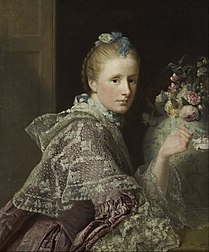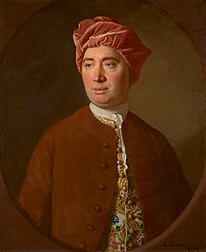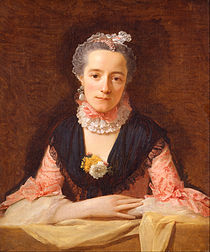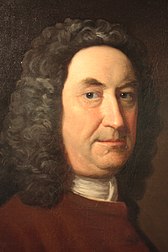Allan Ramsay (artist)
Allan Ramsay | |
|---|---|
George III |
Allan Ramsay (13 October 1713 – 10 August 1784) was a prominent Scottish portrait-painter.
Life and career
This section needs additional citations for verification. (February 2024) |
Ramsay was born in
On his return in 1738 to the British Isles, he first settled in Edinburgh, attracting attention by his head of Duncan Forbes of Culloden and his full-length portrait of the Duke of Argyll, later used on Royal Bank of Scotland banknotes. He later moved to London, where he was employed by the Duke of Bridgewater.

His pleasant manners and varied culture, not less than his artistic skill, contributed to render him popular.[2] His only serious competitor was Thomas Hudson, with whom he shared a drapery painter, Joseph Van Aken.
In 1739, he married his first wife, Anne Bayne, the daughter of Alexander Bayne of Rires (c. 1684–1737), and Mary Carstairs (1695?–1759). Anne died on 4 February 1743, giving birth to their 3rd child; none of their children reached adulthood.[3]
One of his drawing pupils was
Ramsay and his new wife spent 1754 to 1757 together in Italy, going to Rome, Florence, Naples and
He gave up painting in about 1770 to concentrate on literary pursuits. His health was shattered by an accidental dislocation of the right arm and his second wife's death in 1782. With unflinching pertinacity, he struggled until he had completed a likeness of the king upon which he was engaged at the time, and then started for his beloved Italy. He left a series of 50 royal portraits to be completed by his assistant Reinagle. For several years he lingered in the south, his constitution finally broken. He died at
Ramsay was a friend of Samuel Johnson's, who said of him, 'I love Ramsay. You will not find a man in whose conversation there is more instruction, more information, and more elegance, than in Ramsay's.'[7]
Art

Among his most satisfactory productions are some of his earlier ones, such as the full-length of the Duke of Argyll, and the numerous bust-portraits of Scottish gentlemen and their ladies which he executed before settling in London. They are full of both grace and individuality; the features show excellent draughtsmanship; and the flesh-painting is firm and sound in method, though frequently tending a little to hardness and opacity. His full-length of
In a documentary broadcast by the BBC in February 2014, Ramsay was shown to be the artist who painted the lost portrait of Charles Edward Stuart in 1745, completed on the verge of his invasion of England.[8]
Paintings

Ramsay has paintings in the collection of a few British institutions including the National Gallery in London, Sheffield, Derby Art Gallery (attributed), Glasgow Museum and Newstead Abbey.[9]
In 2016 a portrait of Richard Mead (King George II's physician) by Allan Ramsay was discovered by Bendor Grosvenor (using the Art UK website) as part of the British BBC4 television programme Britain's Lost Masterpieces; conservation treatment was carried out by Simon Rollo Gillespie to repair the torn canvas and remove layers of discoloured varnishes.[10]
One of Ramsay's most famous paintings is entitled simply "Portrait of an African" and has attracted extensive attention across recent decades, both as a representation of an individual African in 18th century Britain, but also for the difficulty of identifying the sitter. A documentary featuring this painting explores the many meanings of this enigmatic images has been produced by Royal Albert Memorial Museum & Art Gallery in Exeter.[11]
Theory
In 1755, Ramsay made a considerable contribution to the Greco-Roman controversy, which was mainly discussed in Paris and Rome, when he anonymously published his Dialogue on Taste in which he named Greece as the superior source of artistic excellence.[12]
Abolitionism and paintings of Queen Charlotte
The examples and perspective in this article may not include all significant viewpoints. (January 2020) |
According to Mario de Valdes y Cocom in 2009 on an edition of PBS Frontline, in several paintings of
Other historians question whether the 13th-century ancestor, referred to in various places as a 'Moor' and
- Allan Ramsay's works
-
Self-portrait
-
Portrait of his second wife, Margaret Lindsay
-
The lost portrait of Charles Edward Stuart, painted in Edinburgh in 1745
-
Queen Charlotteas painted by Allan Ramsay in 1762
-
Portrait of David Hume, 1754
-
Portrait of David Hume, 1766
-
Lady in a Pink Silk Dress
-
John Burgoyne, painted in Rome in 1758
-
Sir John St. Clair, 1754

Writings
- A Dialogue on Taste 1762 ;(Kessinger Publishing 2009) ISBN 978-1-104-59212-7
- Letters on the Present Disturbances in Great Britain and her American Provinces 1777 ; (Gale ECCO 2010) ISBN 978-1170488447
- Observations on the Riot Act 1781 ; (Gale ECCO 2010) ISBN 978-1170486757
References
- National Galleries of Scotland, Edinburgh, p. 27
- ^ a b c d e One or more of the preceding sentences incorporates text from a publication now in the public domain: Chisholm, Hugh, ed. (1911). "Ramsay, Allan". Encyclopædia Britannica. Vol. 22 (11th ed.). Cambridge University Press. pp. 878–879.
- ^ a b "Anne Bayne, Mrs Allan Ramsay, d. 1743. Wife of the artist Allan Ramsay" National Galleries of Scotland accessed 15 May 2016.
- ^ Ramsay to Lindsay, 31 March 1752, A. Smart, Allan Ramsay: Painter, essayist, and Man of the Enlightenment (1992), 96 n. 10
- ^ Pech, H.T.; Peabody, S.H.; Richardson, C.F. (1900). The International Cyclopædia: A Compendium of Human Knowledge. Revised with Large Additions. Dodd, Mead. p. 415. Retrieved 1 May 2019.
... On his return, being introduced to the Prince of Wales, afterward George III., he rapidly rose into favor, and in 1767 was appointed principal painter to the king.
- ISBN 9780903598262. Retrieved 1 May 2019.
... On Shackleton's death in 1767 Ramsay succeeded him in the full office of Principal Painter in Ordinary, which, before the ...
- ^ James Boswell (30 April 1778). The Life of Samuel Johnson.
- ^ "Lost Bonnie Prince Charlie portrait found in Scotland". BBC News. 22 February 2014. Retrieved 23 February 2014.
- ^ Allan Ramsay, BBC; accessed August 2011.
- ^ McLaren, Rob (7 October 2016). "18th century art masterpiece discovered in Montrose after being neglected in store room". TheCourier.co.uk.
- ^ In Plain Sight: Portrait of an African, retrieved 1 November 2022
- ISBN 0-19-284222-6.
- ^ a b "The blurred racial lines of famous families – Queen Charlotte". PBS. Retrieved 26 September 2012.
- ^ Stuart Jeffries, "Was this Britain's first black queen?" The Guardian, 12 March 2009
Further reading
- ISSN 0264-0856
- Macmillan, Duncan (2023), Scotland and the Origins of Modern Art, ISBN 978-1-84822-633-3
External links
- Works in the National Galleries of Scotland
- Nigel Warburton on the significance of two portraits of Hume and Rousseau
- Art "4" "2"-Day – Collection of Short Biographies
- Web Gallery of Art – more examples of Ramsay's work
- 236 artworks by or after Allan Ramsay at the Art UK site
- Alastair Smart Archive - Research on Allan Ramsay













